When something new comes on the market, whether it’s a new model of car or an entirely new technology, it’s not adopted all at once. First some try it, then others. And the process is fairly well understood. That’s where we get adoption curves from.
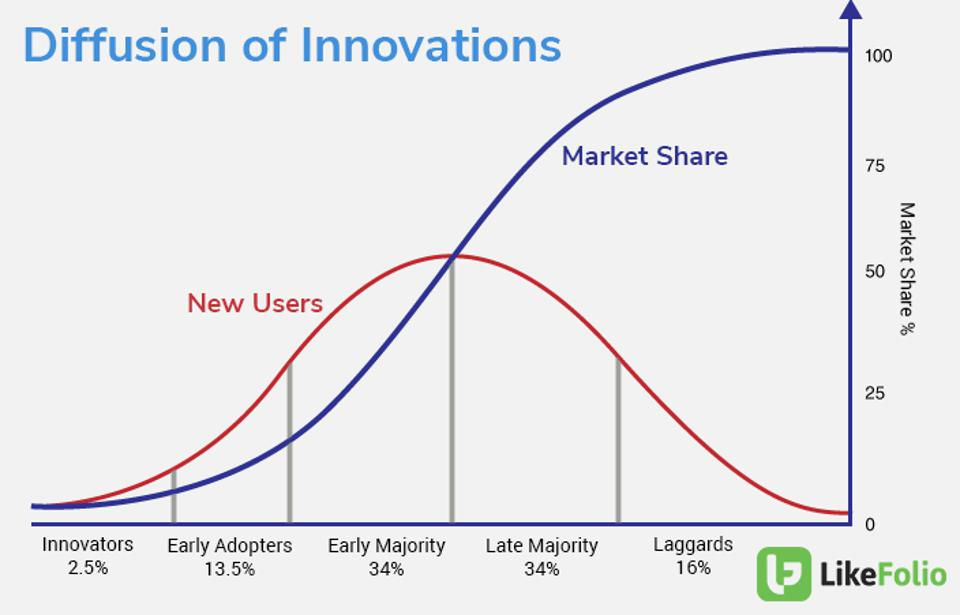
Note that there are two curves here. One deals with the stages in which the product is adopted, the other with market share or total users. We’ll start with the curve showing adoption by users.
How adoption happens
So you can look back on the adoption process of cell phones, which are now utterly ubiquitous, with most families having one or two old ones around the house as well as one per household member. When they came out, they were big, clunky and awkward.

This was a product that came with a single upside: you could make phone calls wherever you were. But it came with a lot of downsides: it was heavy and large. You can’t put this in your pocket or purse. This is a briefcase-or-backpack product. They had poor support: batteries were weak, cell towers were few.
They were expensive, so the utility of being able to make a phone call from anywhere came at a stark cost. And the prior generation of technology, in the form of payphones where you could make a call for a few cents, were everywhere: public parks, hotel lobbies, taxi ranks, convenience stores.
So not many people bought the first generation of cell phones. Those who did either strongly benefitted from the available utility — it really paid for them to be able to make and receive calls anywhere — or were enthusiasts for the technology in general. If you saw someone in the late 80s on a cellphone, they were a stockbroker or an engineer.
Later, the use cases for cellphones grew, and the support network for them also grew. They began to be adopted by more people; not just innovators, but early adopters, people for whom the benefit of not having to use payphones and being able to talk on the go were tangible (payphones were sometimes pretty unpleasant).
What’s happening here is that each generation of adopters is paying for the next one by making the technology better and keeping alive the companies that make it while it improves.
Next came the early majority: relatively well-off, relatively tech-savvy people had mobile phones by the middle 1990s. By the late 1990s it was normal to have a phone, and one sign of that was that a workhorse mobile phone, the legendarily indestructible Nokia 110 series, had hit the market and become popular. And by the early 2000s, the market was more or less saturated — just in time for the iPhone in 2008.

The market share adoption curve
This process of adoption, where different sectors of a market come on board with a new product or technology at different stages and for different reasons, can be applied to nearly everything. We can see it across whole societies, or in niche markets; and we can see it in new technologies like the petrol engine, electricity or steam power, and in new consumer goods like the smartphone or the personal computer.
Adoption curves look smooth and seamless because they measure which members of a potential market get on board at which stage of its popularization. But when we look at market share, rather than the classic adoption curve, we see something different:
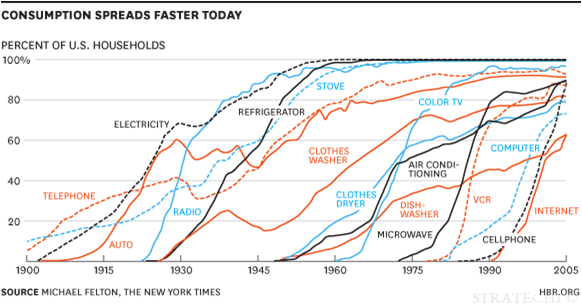
There are obvious reasons why some of these curves have their shapes — adoption of most new technologies took a step back in the Great Depression, for instance. But there’s one thing we can generalize about: the later a technology was introduced, the faster it was adopted. Look at the adoption curve for mobile phones, VCRs and air conditioning: they’re extremely rapid.
Why should that be? Partly it’s because it’s a measure of velocity; how long does it take the early and late majority, by far the largest portion of market share, to come on board? Cellphones were being sold to people who had had telephones for generations, knew what a walkie-talkie was and were familiar and comfortable with communication devices. Electricity was being sold to people who used oil lamps and wood stoves. So electricity was a slower sell.
Partly it’s for the same reason that DeFi is taking off faster than digital assets did. Bitcoin itself was adopted with greater rapidity than most previous technological innovations:
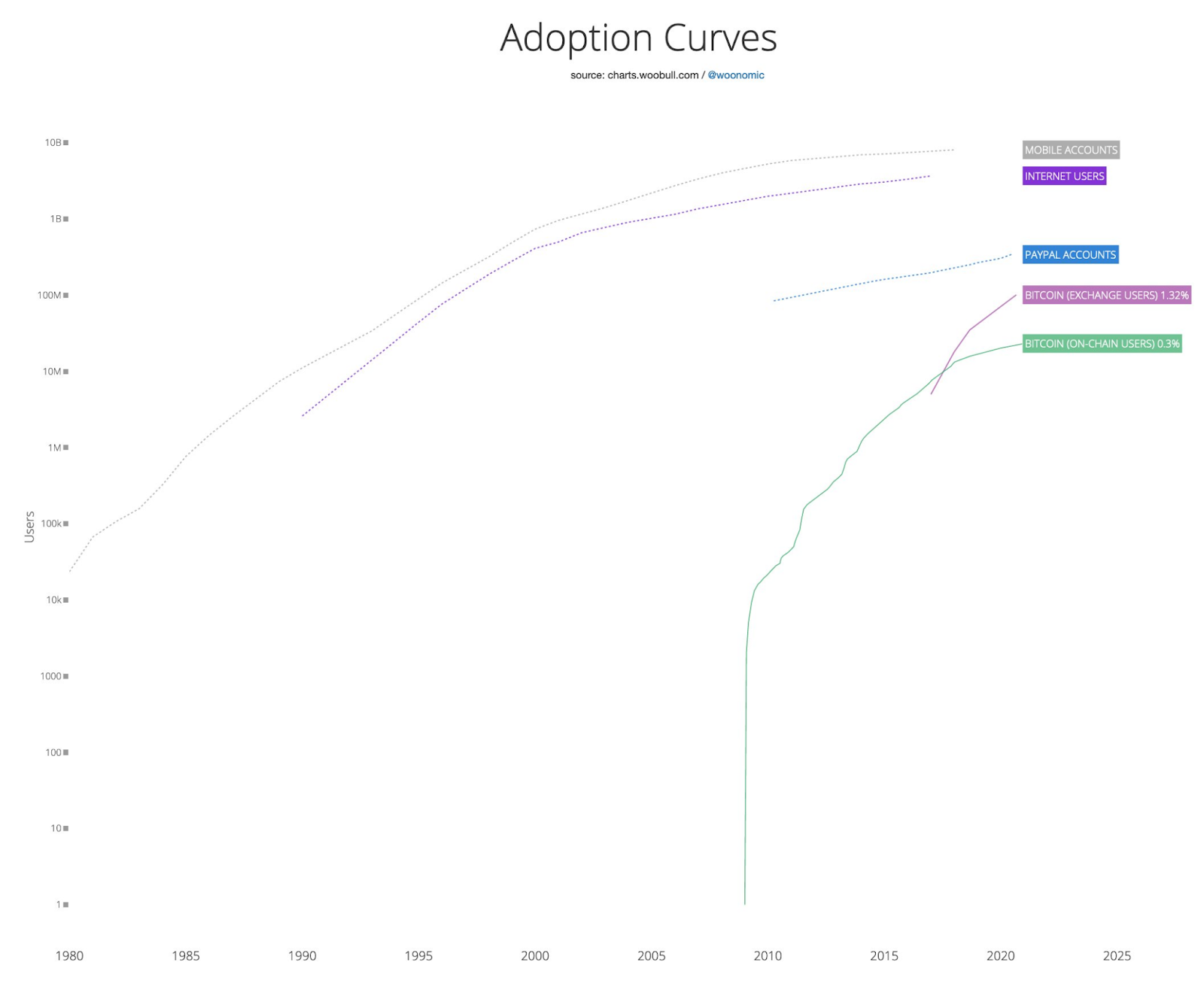
The underlying technologies are all in place. Bitcoin is being adopted by people who already have an internet connection, a mobile banking app, Paypal… Similar and supporting technologies are already there. But partly it’s because the choice to adopt is less consequential, something else that can change the shape of the adoption curve.
For instance, installing electricity in a house that doesn’t already have it is a major undertaking. It’s a major undertaking now, let alone in a period where electrification wasn’t the norm. But installing a washing machine in a house that already has mains water and electricity is relatively low-cost and simple, and as the technology was adopted more widely it became simpler and lower-cost. This in turn encouraged more rapid adoption.
In the case of Bitcoin, adoption can lead to rapid gains, not just lower expenditure, and the amount investors stand to gain has grown steadily too, acting as an amplifier to the natural shape of the process and generating an adoption curve that’s almost vertical for the first 100,000 users.
Survivorship bias and the adoption chasm
There’s another crucial issue with the traditional adoption curve too. Not every technology gets to go through the whole process. For every new technology that really did turn out to be a genius idea, like light bulbs, there are dozens of others that just never made it. The digital personal organizer was reborn as the Blackberry; Da Vinci had no motor for his helicopter. Sometimes there’s nothing wrong with the idea, per se, but all the pieces just aren’t ready to come together. Whatever the reason, the technologies we do have are mostly subject to an effect called survivorship bias.
If you have never heard of this, here’s the classic explanation, accompanied by the classic illustration. In the second world war, planes that came back damaged from flights had characteristic patterns of damage, like this:
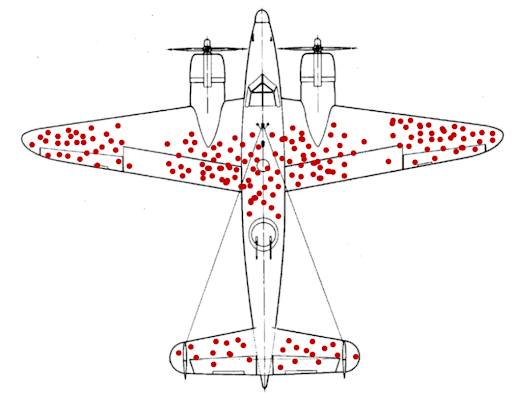
The solution was obvious: armour those parts. But that didn’t result in more planes coming back. Because these are the areas you can damage a plane and it can still fly. They weren’t seeing planes with wrecked engines because those planes never came back.
In the same way, we aren’t seeing the full story of our technologies, or getting a full view of what the fate of new technologies can be, if we ignore the huge chasm in the adoption curve.
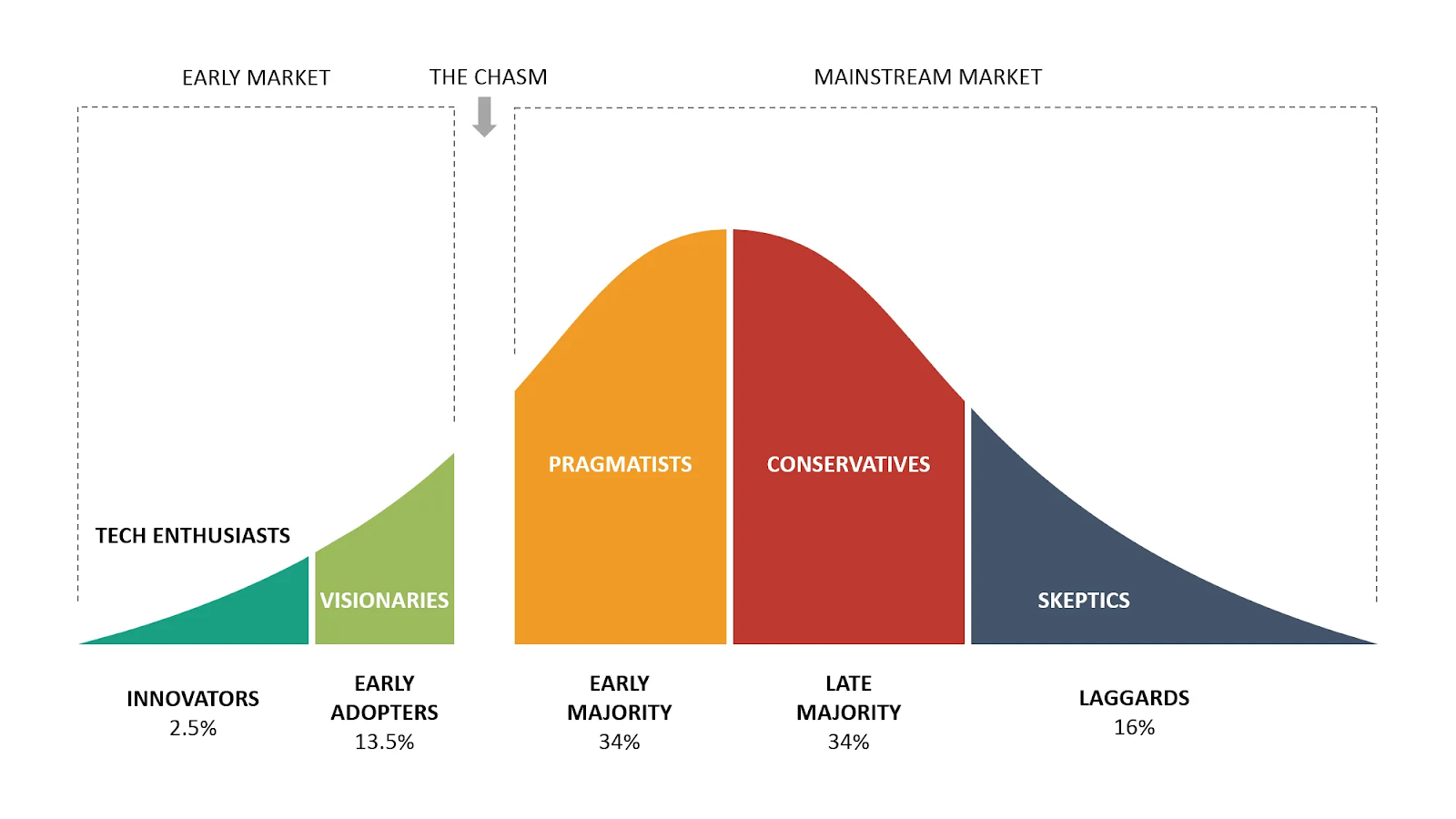
Many technologies are only adopted by tech enthusiasts and visionaries: the jump to popular adoption never comes. Examples include Betamax, the Sinclair C5, the Apple Newton, and many others. So early in the game, innovative tech and services companies need to have an eye to survivability, which means figuring out a way across the chasm.
That isn’t always to do with finding ways to prove the value of the product. For instance, everyone knew Betamax were really good at what they did. (If you don’t remember, Betamax was a kind of videotape.) They were hugely popular with the kind of people who cared deeply about picture quality and audio reproduction. Which is to say, tech enthusiasts and early adopters. But what was hugely popular with everyone else was a vastly inferior product, VHS. VHS had poorer picture quality, didn’t last as long — it was worse in all ways but three. Those three things can tell us a lot about how a technology can jump the chasm and find mass adoption. They were:
- Price. VHS was cheaper for the consumer
- Common standards. The owner of Betamax refused to license the technology, preventing the development of a community interested in its success
- User experience. Betamax was harder to set up at home
The loss of Betamax hardly matters now that we can watch anything we like in pinsharp digital media. But it can tell us how to clear the adoption chasm. You need a community and common operating standards. You need a price your market can afford, and that it thinks is worth the utility. And you need a user experience that your market can engage with. For Bitcoin, the emergence of user-friendly, low-cost onramps like Binance helped drive consumer adoption. At the same time, the emergence of protective legislation and a fintech ecosystem focused on services and enterprise-level security helped attract institutional investors. Digital assets have cleared the adoption chasm. The next steps will be exciting.
